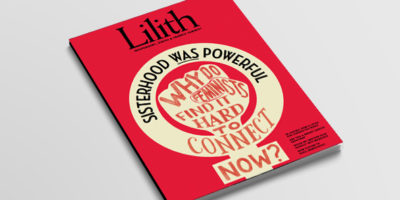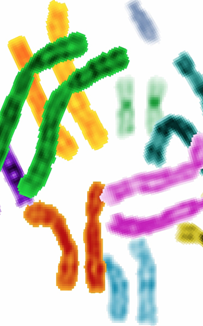
I Am A Cancer Previvor
The killer sweeping through generations of women in her family turns out to be lurking in her own genes too, a revelation with deeply consequential decisions for getting tenure, bearing children and staying alive.
Cancer runs in my father’s family. Around the time I was born, cancer swept through my paternal grandmother’s generation, leaving no women behind. Among its victims was my grandmother, Hadassah Rubel, a beloved Hebrew and music teacher in her Queens Jewish community. She died of ovarian cancer at age 58, about two years shy of my birth: I was given her name to honor her memory. We are connected through that name, and through the songs that she taught her son, my father — and also in more invisible, genetic ways.
When the next generation came of age, the cancer trend again showed its face. My father’s only sister, Susan Rubel, my Aunt Suzi, first endured breast cancer and a mastectomy in her 40s, only to be ravaged by ovarian cancer a decade later. Like the women in the generation before her, she too was a teacher, a reminder that the tendency toward cancer is not the only thing that is in our genes. This familial tendency toward cancer became quantified when my aunt’s doctors identified a mutation in her BRCA1 gene, a mutation associated with increased risks of breast and ovarian cancer. She had inherited it from her mother, and this finding rippled through the family.
Here’s a macabre math problem: what are the chances, in a family of three children, that only one child, or in this case, only Suzi, had received the mutation? Both of my aunt’s brothers had the genetic test; one was spared from this and the other, my father, was not. My father’s DNA has the same BRCA1 mutation, giving l’dor va’dor, from generation to generation, new meaning for me and for my siblings. With this information, I was told that I had either inherited this mutation or, with equal likelihood, had not. I debated getting tested — there is no cure for a BRCA1 mutation. You can’t change it. Besides, each of us will die, at some point and in some way. Why try to forecast the details? Why might I, or anyone, want to know more than that?
At the time I faced the decision about whether to have the genetic test, cancer was overpowering my beloved aunt, and she was clearly not going to survive. She had spent the last decade of her young life struggling with disease and would leave behind two twentysomething sons and a loving husband. Her cancer was unstoppable, and our family was forced to continue on without her. My two daughters (not my genetic offspring, a fact relevant here only in this tale of genetics) were six months and 10 years old at the time, and I wanted the dots of my own timeline to be connected differently from Suzi’s. I figured that knowing if I carried this mutation would enable me to make wiser decisions to try to keep myself healthy. I didn’t want my own story to have the same heartbreaking ending. And, of course, an essential component in choosing to undergo genetic testing is the hope of learning you have been spared.
Within a week’s time, I learned that I, too, have the BRCA1 mutation, known as 185delAG. News but not new; the newness was knowing about it. This particular mutation, a missing piece in the 185th position of a very long strand of DNA, has been a part of every one of my cells from the very start.
Increased risks of breast and ovarian cancer mean what? We take risks every time we leave our homes. What’s a little more risk? But an 80 –90% chance of developing breast cancer doesn’t sound as much like a risk as it does a near sure thing. Many people survive breast cancer, like my mother (who does not have a BRCA1 mutation), and go on to live otherwise healthy lives. However, treatments effective for breast cancer typically are not effective on the tumors common in the cancers that women with BRCA1 mutations develop. As if the high breast cancer rates are not enough, women with this BRCA1 mutation have about a 50% lifetime chance of developing ovarian cancer. And because ovarian cancer is difficult to detect until after it has spread, it is usually lethal.
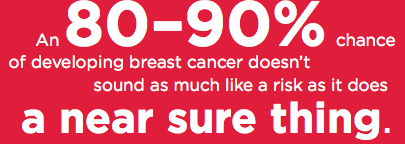
Where did my newly acquired knowledge about my genes leave me? I could hope that the cancerous cells never grow, watch very carefully, aim to catch any cancer quickly and then treat it. This plan sounds stressful, but many women sensibly go this “surveillance” route. But there is a catch. The surveillance relies on mammography and MRIs, and these cannot be undergone during pregnancy. Doctors looked me squarely in the eye and expressed great concern about my going forward with a pregnancy, at age 36 with this BRCA1 mutation. Since pregnancy releases hormones into the body that trigger breast growth, they recommended that if I wanted to birth a baby I should first have a bilateral mastectomy. Once I finished any and all childbearing, they said I should then have my ovaries removed. Oh, and if the extent of all of this wasn’t enough, the doctors also cautioned that optimally the target finish date of all this should be no later than age 40.
With this news, I was facing three overlapping timelines. As a university professor, I was working to produce publications and earn grants as part of a challenging five-year tenure timeline. As a 36-year-old woman, my fertility clock was nearing alarm mode. And most significantly, there was this new timeline, with the highest stakes. Genetic cancer specialists were not neutral about my position. They pleaded with me to do all that was possible, right away, to try to prevent the cancer from ever getting started in my body.
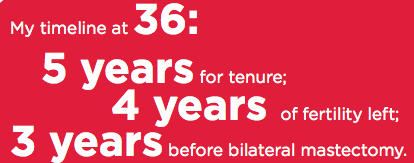
Can you imagine doctors advising you to quickly and preemptively cut off parts of your healthy body? Some friends expressed disbelief that I would even consider it. In that first year, during regular visits to the cancer hospital for the surveillance appointments, I sat in beautifully appointed waiting rooms and faced women visibly ill with cancer. I was an imposter, a patient in a cancer center who didn’t have cancer. I felt lucky to have choices, choices that eluded these women.
And so, before my 37th birthday, with either bravery or cowardice (I still don’t know which), I underwent a bilateral mastectomy. And I still don’t know how to tell people casually about this decision, the experience, the physical pain and recovery, the trauma of losing these body parts. It was awkward. I had not been sick; the surgery was prophylactic, entirely a matter of prevention. I struggled for words to explain something so private and so personal to colleagues and even to friends.
Some misjudged the situation. When I returned to work, a male colleague who knew about the surgery handed me a gift box. At first I was touched he had made a gesture of kindness. I was then horrified to open it and discover chocolate lollipops in the shape of breasts. He had missed the point entirely. This isn’t about breasts. It’s about life, and about navigating difficult choices. I’ve heard of women holding “boob voyage” parties prior to a mastectomy, and I respect any way to gather community to support and mark this significant event. But guys, here’s a hint: make sure you’re actually invited to the party before you break out the boob lollipops.
After my body healed from the mastectomy, I moved on to project pregnancy. I struggled for nearly a year to get pregnant. Every failed attempt was complicated with tinges of grief over what I had lost in pursuit of trying to bear children. I was blessed, so blessed, to eventually get pregnant and bear a son, and then a second son, all by age 40. My process of earning tenure was successful too, though dwarfed in perspective by these grander matters.
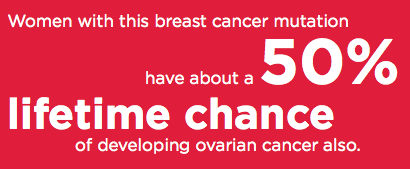
The final step remained, another prophylactic surgery. This time it was to remove my ovaries and fallopian tubes, and was supposedly going to be the easier one. Ovaries are tiny, and they can be removed with very small incisions, performed by robotic instruments. Ovaries, I was told, were not necessary or significant beyond childbearing. But surgical menopause (they don’t call it radical for nothing) brings with it a host of side effects and risks, only some of which are deeply understood by doctors today. After all, it is a new thing for a young healthy woman to have her ovaries removed. Normally, women’s hormonal levels change very gradually and their ovaries produce a range of hormones even after menopause. My ovaries were taken and all ovarian hormone production with them.
Doctors simply do not have the aggregation of data yet to have anything close to comprehensive knowledge about the host of trade-offs here. For example, they warn that with the exit of my ovaries, I have invited increased risks of osteoporosis and heart disease. Hormone replacement therapy (HRT) can replace some of the hormones that the body produces with synthetic substitutes, safer for me since I had a mastectomy and can worry less about breast cancer. The HRT helps with hot flashes and sleeplessness, but there are other effects of radical menopause that the HRT is not alleviating. There is more to the mix of the body’s hormones than what is replaced with standard HRT.
I feel as if the prophylactic removal of these organs has not only cut these supposedly nonessential, female parts out of me, but also that it has changed me — spiritually, experientially, of course, but also chemically and biologically — in essential ways. I traded in parts of my body, parts of me, as a way to take charge of my genetic destiny. I did this from a fortunate position of health. I look in the mirror and see someone familiar, but my brain just does not think like the brain it was before.
Since the oopherectomy, the removal of my ovaries, I struggle to remember details, names and words, all things I excelled at before. I have difficulty learning new information, strange for a person whose profession is academic scholarship. Where I once was an avid reader, often unwinding at the end of the day with a novel, I have not been able to read a book for pleasure since that operation. The words swim on the page, I have difficulty focusing, and I can’t piece together the details of a story, no matter how gripping or well written. I’m no longer comfortable with my body the way I used to be and cannot casually change my clothes in front of people the way I once did, which has turned pools and gyms into places of dread. When my boys were babies, I silently suffered through self-righteous lectures about the long-term health benefits of breastfeeding by people who noticed me bottle-feeding my sons.
And there is no guarantee that my actions have prevented me from ever getting cancer. Cancer could still grow in my epithelial cells or in breast cells that were left behind, or somewhere else in my body. I continue to be regularly screened at the cancer center.
Despite all of these drawbacks, at age 45 I remain cancer free. I am here, to smell the lilacs of the spring and to watch my children grow. So many other brave women who are facing cancer do not have this good fortune. Every follow-up visit back to the cancer center reminds me in a vivid way just how lucky I am. I took painful measures with drastic consequences and difficult tradeoffs, but was there really a choice? Maybe I chose life, or maybe I was just choosing Not Cancer. I am thankful for my wise doctors and grateful for their care. And yet, how can prophylactic surgeries be our best answer?
We need new terminology for people in this position. Doctors might call me an “unaffected carrier,” since I have a BRCA1 mutation but have not had cancer. This term seems wildly inaccurate. The language is important, because the terminology brings with it protective laws related to disability, insurance, and medical research. Hence the term “previvor” — an individual who is a survivor of a predisposition to cancer but has not had the disease — coined by Facing Our Risk of Cancer Empowered (FORCE), an organization to improve the lives of individuals and families affected by hereditary breast and ovarian cancer.
The field of genetic research is so new that it makes me a pioneer of sorts, navigating a little-charted terrain. Increased funding for research is needed, research that has to produce responses better than prophylactic surgeries. Looking back over the layers of decisions I made, I am not saying that I would do it any differently. I likely avoided having breast cancer with toddlers in tow, a cancer that likely would not have been stoppable. The idea that I will be able to be a mother to my children even as they become adults, a partner to my spouse as we grow older, and to work longer toward tikkun olam, repairing the world, validates all the choices I made. But there was a serious price, a price that can be overlooked in the characterization of breasts and ovaries as non-essential body parts. I continue to pray that I will avoid the experience of having ovarian cancer and be able to live a longer life than so many other women in my family. I hope my story will help other women think through their own choices and that my voice will communicate the urgency that we not be satisfied with these prophylactic surgeries as our best response. Breasts and ovaries are essential parts of a female body, and we can all hope that medical responses to genetic cancer mutations recognize their importance, and offer us better — and less wrenching — options.
Laurie Rubel lives in New York with her family and is on the faculty of the City University of New York. An earlier version of this essay appeared at kveller.com.

